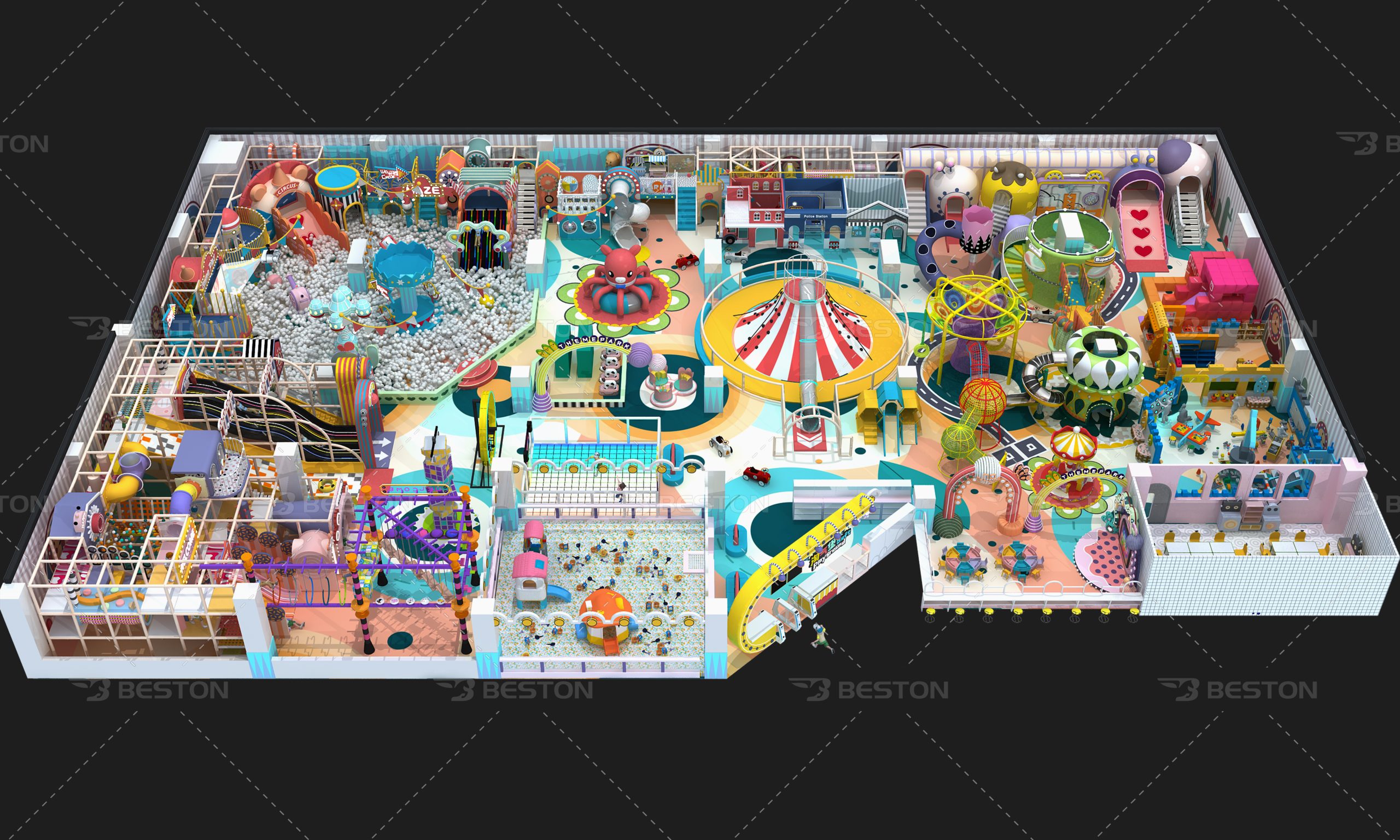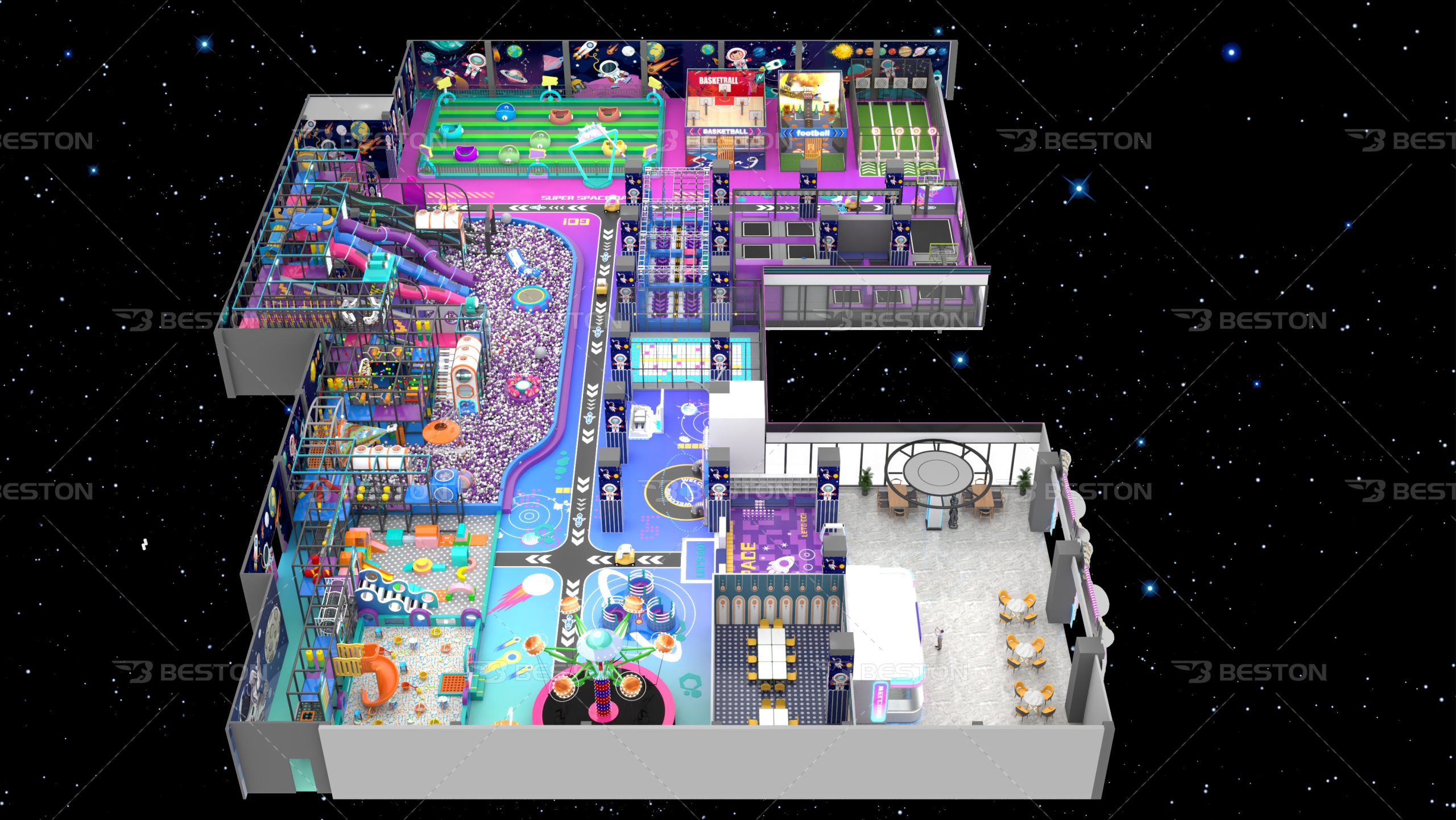Indoor playgrounds are thriving spaces that combine imaginative play and physical activity in a controlled environment. For business owners and planners looking to incorporate an indoor playground into a commercial venue, designing one that balances fun and safety is critical. The following guide delves into creating an effective indoor playground, covering everything from strategic layout choices to material selection.
The Blueprint of a Safe Indoor Playground
Creating a compelling playground begins with a well-thought-out layout. The layout should optimize available space while providing distinct zones for various activities, ensuring young children can explore, climb, slide, and play without overcrowding. Well-planned spatial design minimizes collision risk and enhances the flow between sections, especially in areas with high foot traffic.
When designing a commercial indoor playground equipment setup, zoning for age-appropriate activities is essential. Toddlers, for instance, may benefit from smaller, soft-play areas featuring low climbing structures and padded obstacles. Meanwhile, older children could enjoy more challenging apparatuses such as rope courses or indoor rides from reputable amusement ride manufacturers. Clear boundaries between age zones help maintain safety and promote independent exploration, a vital aspect of effective indoor playground design.
Prioritizing Safety in Playground Materials and Components
The choice of materials is crucial for safety and durability. High-density polyethylene (HDPE) is often used for play structures due to its non-toxic and durable nature, ideal for various indoor playground equipment for sale. HDPE also resists bacteria and is easy to clean, an important feature for busy commercial spaces.
Flooring materials should absorb shock to reduce the impact of falls. Foam padding, rubberized tiles, and synthetic turf are popular choices. Each material offers its unique benefits: foam provides softness, rubber ensures traction, and synthetic turf adds aesthetic value while maintaining comfort.

Safety Standards and Compliance
Following industry standards established by organizations such as ASTM International is essential. These standards outline criteria for impact attenuation, surface stability, and overall design specifications for indoor playground components, including indoor rides. Properly labeled safety signage should accompany more challenging equipment, instructing users on age limits, weight restrictions, and appropriate use techniques.
To enhance safety, consider integrating protective barriers or netting around elevated structures. Such barriers prevent falls from climbing walls, slides, indoor rides, or other elevated elements, keeping children within safe boundaries.
Enriching the Playground Experience with Varied Play Options
The most successful commercial indoor playground equipment features an array of play options, combining physical challenges with imaginative spaces. Customizable indoor rides add a dynamic element, ranging from mini carousels to spinning tea cups. Amusement ride manufacturers now offer compact, child-friendly rides specifically tailored for indoor use, ideal for adding excitement to playgrounds without consuming excessive space.
Combining active play areas with interactive components like sensory walls or storytelling zones broadens the appeal of the playground. Sensory walls provide tactile and auditory stimulation for children, fostering cognitive development and sensory awareness. Storytelling zones, equipped with seating and visual displays, create relaxing spaces where children can unwind, fostering a balance between high-energy and restful activities.

Incorporating Digital Interactivity
Modern indoor playgrounds increasingly incorporate digital features. Interactive touch panels or augmented reality games add a unique technological aspect to playground design, engaging older children while keeping them active. Carefully balanced, these interactive components add to the playground’s appeal without replacing the essential physical play that defines a playground’s purpose.
Ensuring Accessibility for All Users
Accessibility is a vital consideration in the design of commercial indoor playground equipment. Integrating inclusive equipment allows children of all abilities to enjoy the playground, promoting social integration and inclusive play. Ramps, wheelchair-accessible platforms, and transfer stations on slides ensure children with mobility challenges can participate.
Handrails and low barriers in climbing areas provide additional support, enabling children with differing abilities to move confidently. Soft play areas with textured flooring also support sensory exploration, appealing to children with sensory processing needs.
Thoughtful Considerations for Parents and Guardians
A well-designed playground prioritizes the comfort and convenience of parents and guardians. Incorporating seating areas with clear sightlines to all play zones enables caregivers to observe children without needing to hover nearby. Strategically placed benches and lounge chairs not only provide a space to rest but also encourage longer visits, which can increase customer satisfaction and, consequently, customer retention.
Furthermore, clear signage, detailing rules and safety guidelines, helps parents feel more comfortable while supervising their children. By ensuring that guardians understand the playground’s safety protocols, business owners can create an environment that feels secure for all visitors.
Maintenance: The Key to Longevity and Safety
Regular maintenance is essential to keep indoor playground equipment in safe, functional condition. Daily inspections of equipment help identify wear and tear, ensuring small issues are addressed before they become safety hazards. Structures like slides, climbing walls, and indoor rides require close monitoring, as frequent usage can lead to loosening bolts, weakened materials, and other risks.
Cleaning routines are equally important, especially in a high-traffic environment where germs and bacteria can spread. Commercial playgrounds benefit from non-toxic cleaning solutions that disinfect without damaging surfaces. Periodic deep cleaning and surface sterilization not only protect children’s health but also maintain the equipment’s appearance and longevity.
Choosing the Right Manufacturer
Selecting a reputable manufacturer for indoor playground equipment for sale is critical. Quality manufacturers prioritize safety, durability, and compliance with international standards. When researching amusement ride manufacturers, look for those with a track record of reliability, particularly with indoor playground solutions. Investing in high-quality equipment from a reputable supplier reduces the likelihood of malfunctions and enhances the playground’s long-term performance.
Moreover, a strong manufacturer often offers customization options, allowing business owners to tailor equipment to match the unique theme or size constraints of their venue. Whether opting for traditional slides and climbing frames or more advanced digital play elements, reliable manufacturers provide comprehensive solutions that support an engaging, safe environment for children.
Balancing Creativity with Practicality in Playground Design
Designing a playground requires a balance between creative expression and practical safety considerations. While vibrant colors and imaginative structures attract young visitors, thoughtful design choices should prioritize unobstructed sightlines, non-slip surfaces, and reliable equipment. Creativity should serve functionality, ensuring the playground layout and elements engage children while minimizing risk.
Opt for color schemes and themed designs that align with the overall ambiance of the commercial venue. If the playground is part of a shopping mall, a theme that complements the mall’s architectural style or branding can enhance its appeal. Alternatively, unique themes like space exploration or tropical jungles can transform the playground into a visually captivating attraction, making it a standout feature for both children and adults.
Conclusion
Creating a fun and safe indoor playground involves a meticulous balance of design, safety, accessibility, and maintenance. With the right commercial indoor playground equipment, businesses can foster a space where children are free to explore, climb, and play without compromising their safety. Working closely with trusted amusement ride manufacturers can ensure access to a range of high-quality, engaging indoor rides and structures.
An indoor playground that combines playfulness with robust safety features will ultimately deliver an unforgettable experience for children, meeting both the operational needs of the business and the entertainment demands of families.